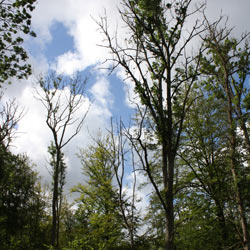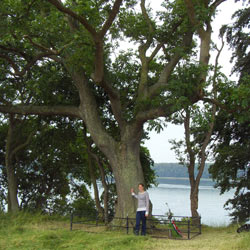Ash trees that can survive the emerging infectious die-back disease
Ash trees are threatened in most parts of its natural distribution area, including Denmark by the emerging infectious pathogen Hymenoscyphus pseudoalbidus. The forest genetic research group at Forest & Landscape, University of Copenhagen is studying if and how active genetic management can ensure the species a future in Danish forests and landscapes.
During the last decade an emerging infectious pathogen Hymenoscyphus pseudoalbidus has spread across Europe causing devastating damage on ash trees and associated plant communities.

Ash trees (Fraxinus excelsior) with characteristic symptoms of H. pseudoalbidus damage were first observed in Denmark around 2003. In 2008 it became clear that the disease is caused by a fungus, but the pathogen was only properly identified in 2010.
In Denmark ash trees are rarely planted any more, and mature trees are being logged intensively in order to harvest timber before the quality deteriorates. This previously common tree species is disappearing from forest ecosystems.
Few trees seem to be able to resist the fungus
Due to the severity of the problem, it has become a priority with the forest genetic research group at Forest & Landscape, University of Copenhagen, to study if and how active genetic management can ensure that the species have a future in the Danish forests and landscapes.
As one of the few international research groups, we study the degree of inherited natural genetic resistance of the ash trees to the new disease.
We have measured the level of susceptibility of 39 F. excelsior clones during the last five years in trials at two sites.
The results are positive in the sense that we do find substantial genetic variation between trees in their level of susceptibility. However, the proportion of trees with a high level of natural resistance seems to be very low, probably less than 5%.
The results were published last year in Heredity 106: 788-797 (May 2011).
An active defense that limits fungal growth
An intriguing result in the above clonal study was a surprisingly high correlation between phenology of the F. excelsior clones and their degree of susceptibility. We speculated that the variation in susceptibility may be related to time of leaf shedding, because we assume the pathogen infects the trees through the leaves in the autumn (the infection biology is still not fully understood). We therefore made an inoculation study, where we artificially infected trees with the fungus, placing it directly on branches and assessing the speed of development of the necrosis around the inoculation site.
In this trial, we tested clones that we had already identified in the previous study as having either a high or a low level of susceptibility to natural infections. Our results showed that the size of the necrosis varied between clones, with a close correlation between the general susceptibility of the clones in field trials and their development of necrosis following artificial infection (inoculation).
An important implication of the results is that the observed high level of resistance in a few trees is likely to be, at least partly, due to an active defence, where the clones limit the fungal growth. Important is also that it seems possible to predict the general level of resistance by applying a fairly fast bioassay based on controlled inoculation followed by assessment of necrosis develop around the point of infection.
The results will be published in Forest Pathology 42: 69-74 (February 2012).
Resistance is inherited
Of key importance for both the evolutionary implications and the practical applicability of our findings is the degree to which resistance is inherited from parents to offspring. We therefore studied offspring from 101 selected trees during the last four years based on progeny trials at two sites.

This study demonstrates presence of substantial additive genetic variation with a high level of heritability (hns2 = 0.37-0.52). This means that resistance is likely to be passed on, to a large extent, by parents to offspring. Again, most of the tested native trees were found to produce highly susceptible offspring, and only 1-3% of the trees produced healthy offspring under the present disease pressure.
These results suggest that the genetic variation in susceptibility can provide the species an important ability to recover in the long run, but that ash trees in the present forests most likely will become severely decimated. The finding will be published in Evolutionary Applications (published on-line 3/12 2011).
Ongoing research focuses on studying the actual genes involved in the resistance, and on host-pathogen interactions.
Save the remaining ash trees
Urgent actions are required if healthy ash trees are to be identified and secured in the forests before they are logged. A substantial survey of the Danish forests will therefore be initiated in 2012. Identified trees will be propagated by grafting and will be established in clonal trials. The campaign will be a joint effort between researchers, foresters and public authorities.
The objective is to safeguard the few percentages of ash trees that have a reputed high level of health, but are in acute risk of being logged. The program will draw on the knowledge generated from past and ongoing research. If successful, the program will allow development of healthy seed sources with high levels of natural resistance to the pathogen. Such germplasm may allow large scale future re-introductions of ash trees into the forests based on planting. The time horizon for development of new, productive seed sources are 10 years or more.
|
Ash - an important tree in forests and landscapes The European Common ash (Fraxinus excelsior L.) is an import species in Denmark. It has been part of the Danish flora for more than 7,000 years, and has until recently been the 5th most important broadleaved species in terms of area coverage in the Danish forests. The species is dominant in forests on moist, fertile soils with good drainage, and is a key species in a unique natural plant community with many associated plants and insects. The ash tree is also an important tree in landscapes and urban areas. |
Contact: Erik Dahl Kjær, Forest & Landscape, edk@life.ku.dk





